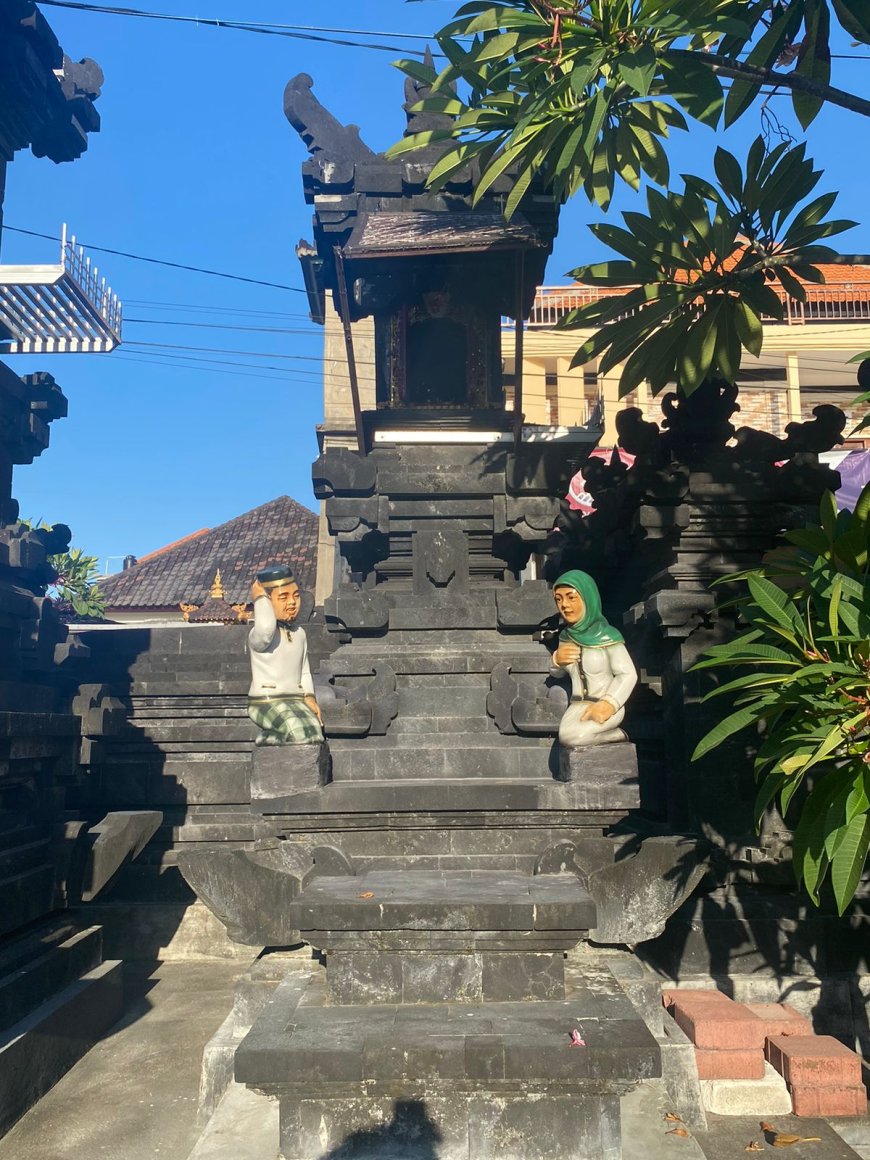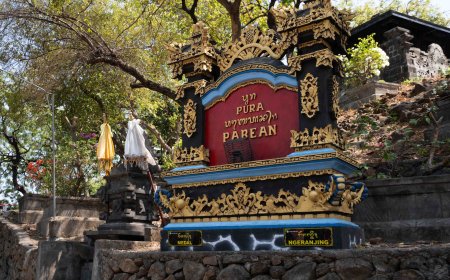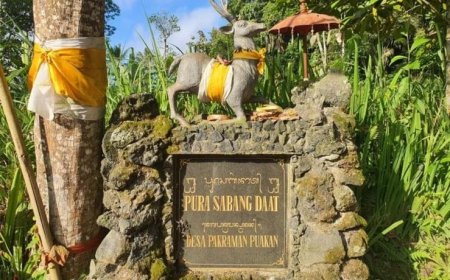Pengawangan Pura Dalem Karang Tengah: A form of Acculturation between Hindu (Bali), Islamic (Java), and Chinese (China) cultures
Pura Dalem Karang Tengah, between Benoa Harbor and Tanjung Benoa, has disappeared. A fisherman from Tanjung Benoa Village built Penyawangan Temple nearby. The Piodalan ceremony at this temple is held every six months on Saniscara Kliwon day, wuku Landep (Tumpek Landep). This temple reflects cultural acculturation and respects three religions: Hindu (Bali), Islam (Java), and Chinese (China).

Bali is a province known as the Island of the Gods and the Island of a Thousand Temples. This term has its own meaning and meaning as the identity of the island of Bali. The island of Bali is dominated by Hindus who believe in and recognize the existence of ancestors and gods. Dewa is the holy light of Ida Sang Hyang Widhi Wasa or God Almighty who gives many holy rays, gifts and blessings to all living creatures in the world. Apart from that, Bali is also often referred to as the Island of a Thousand Temples, which means that there are many temples in all corners and regions of Bali. This temple is a holy place as a residence for the ancestors and gods as a manifestation of Ida Sang Hyang Widhi Wasa, and the temple is also a place of prayer for Hindus. There are also several types of temples in Bali, namely Tri Kahyangan Temple, Sad Kahyangan Temple, Dhang Kahyangan Temple, Leluhur Temple or commonly called Kawitan Temple and others.
The existence of Hindu temples in Bali is not only historical evidence of culture, but there are also several holy places or temples in Bali as evidence of cultural and religious acculturation. One of the temples in Bali which is a manifestation and clear evidence of cultural and religious acculturation is Pura Dalem Karang Tengah in the Tanjung Benoa Traditional Village. Pura Dalem Karang Tengah is located in the Tanjung Benoa Traditional Village, South Kuta District, Badung Regency, Bali Province.
Pura Dalem Karang Tengah is a temple located between Benoa Harbor and Tanjung Benoa which is currently invisible. Initially, Pura Dalem Karang Tengah was shaped like a mound of white coral surrounded by a deep sea trough. The location of Pura Dalem Karang Tengah is the meeting area of five rivers, namely the Suwung River, Badung River, Candi Darmada River, Jimbaran River and Terora River. In ancient times, when Benoa Harbor was still used as a trade route, traders and fishermen who passed by this temple would offer canang or offerings to the Ida Bhatara of Pura Dalem Karang Tengah.
After that, one of the fishermen who was a resident of Tanjung Benoa Village made a linggih for the Dalem Karang Tengah Temple on the coast of the coast area north of Tanjung Benoa Village. But over time, the condition of the pelinggih was affected by abrasion and it was moved and made a Penyawangan temple to one of the places in the Tanjung Benoa Village area, precisely to the north of the Lan Puseh and Catus Pata Village Temples, Tanjung Benoa Traditional Village, which was previously still a jungle. For the year of construction of Pura Dalem Karang Tengah, the ancestors, stakeholders and builders of Pura Dalem Karang Tengah do not know exactly when this temple started to be built. However, there is some historical evidence and the existence of friendly relations and trade relations with the Islamic community (Java) and with the Chinese community (China). Apart from that, there is also evidence of souvenir statues in the form of bronze elephants which are still there and are very well kept and displayed in this temple.

Pelinggih - pelinggih of Pura Dalem Karang Tengah (Source: Own collection)
Initially there was only one family to support or build the Dalem Karang Tengah Temple, but now the Dalem Karang Tengah Temple has grown to 19 families. Pura Dalem Karang Tengah is a Penyiwi or Penyawan temple which is a public temple, so anyone can pray at this temple. Many people from the Tanjung Benoa Traditional Village also offer offerings and pray at Pura Dalem Karang Tengah during holy Hindu holidays and during piodalan every six months which coincides with Saniscara Kliwon day, wuku Landep or commonly called Tumpek Landep.
During the Piodalan at Pura Dalem Karang Tengah it begins with ceremonial work on the sea or beach. The verification was carried out on the sea or coast north of Tanjung Benoa Village, which was the first place or linggih of Ida Bhatara Dalem Karang Tengah before being moved to the current location. However, as time went by, marine tourism at Tanjung Benoa Village Beach began to develop rapidly, so that the existence of places for verification began to be squeezed due to the existence of basic facilities and supporting tourism. Apart from that, on the beach north of Tanjung Benoa Village there is also Pertamina which is very close to the verification site which sometimes disrupts religious activities there. So at this time, religious activities such as ceremonial cleansing and others have been moved to the north-eastern coast of Tanjung Benoa Village, which is close to Dalem Ning Temple, Taman Beji Temple and Caow Eng Bio Temple.

Pelinggih Ida Ratu Gede Ngurah Subandar (Source: Own collection)
Pura Dalem Karang Tengah is very strong in acculturation culture and is a unifying temple that upholds the values of religious and cultural unity and integrity, because in this temple there are three shrines containing Hindu (Balinese), Islamic (Java) and Chinese (Chinese) statues. The shrines at Pura Dalem Karang Tengah include Pelinggih Ida Bhatara Karang Tengah which is the shrine of Ida Karang Tengah as a manifestation of Ida Sang Hyang Widhi Wasa who used to be a shrine and was in the Benoa Harbor area, but currently his form is no longer visible. The second shrine is Pelinggih Ida Ratu Gede Ngurah Subandar who is a shrine to the Chinese faith. The third is the Pelinggih Dalem Majapahit which is the shrine of the Hindu archipelago belief. The fourth is the Pelinggih Ida Dalem Solo which is a shrine of Islamic (Javanese) beliefs and the fifth shrine is the Pelinggih Ida Dalem Mecca, and there is also a sacred gedong called Gedong Penyempenan as the place or linggih of Ida Macan Gading which is the guardian and accompaniment of Ida Bhatara sesuhunan who is at Pura Dalem Karang Tengah.

Pelinggih Ida Dalem Solo (Source: Own collection)
The existence of the pelinggih which contains Chinese statues and the pelinggih which contains Islamic statues at the Dalem Karang Tengah Temple is due to the ancient relationship between the ancestors of the temple builders who were very close to the Islamic community (Java) and the Chinese community from China, which in the past often carry out trade relations in the sea waters of Tanjung Benoa. Apart from that, because of the close relationship between the ancestors and the Islamic community (Java), previously at Pura Dalem Karang Tengah there was a ludruk dance tradition which was exactly the same as the ludruk dance in Java. But as time went by, no one continued the ludruk dance tradition until now and it was finally disbanded. There is also a taboo from the ancestors that cannot be carried out during piodalan or other traditional religious ceremonies at Pura Dalem Karang Tengah, namely that for offerings and other religious facilities you must not use pork at all. This taboo cannot be violated and has been done from ancient times until now.






























































